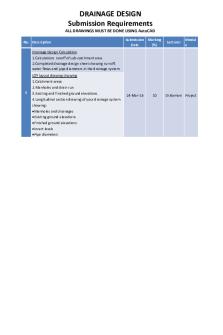Review-WORK- Design PDF

| Title | Review-WORK- Design |
|---|---|
| Author | Ân Lê |
| Course | Management Information Systems |
| Institution | International University - VNU-HCM |
| Pages | 4 |
| File Size | 375.2 KB |
| File Type | |
| Total Downloads | 261 |
| Total Views | 317 |
Summary
REVIEW – WORK DESIGN The snapback timing method was used to obtain average times for work elements in one work cycle. The times are given in the table below. Element d is a machine-controlled element and the time is constant. Elements a, b, c, e, and f are operator-controlled and were performance ra...
Description
REVIEW – WORK DESIGN 1. The snapback timing method was used to obtain average times for work elements in one work cycle. The times are given in the table below. Element d is a machine-controlled element and the time is constant. Elements a, b, c, e, and f are operator-controlled and were performance rated at 85%; however, elements e and f are performed during the machinecontrolled element d. The machine allowance is zero (no extra time is added to the machine cycle), and the PFD allowance is 15%. Determine (a) the normal time for the cycle and (b) the standard time for the cycle.
a) Normalized time for the cycle For elements a, b, c, TABC = 0.25 + 0.3 + 0.2 = 0.75 min For elements e and f, Tef = 0.3 +0.2 = 0.5 min - The normal time Tn = Tnw + Max{Tef(PR), Td} = 0.75x85% + Max{0.5x(85%), 0.4} = 0.6375 + Max{0.425, 0.4} = 1.0625 min b) - The standard time for the cycle Tstd = 0.6375 x (1 + 0.2) + Max{0.425 x (1 + 0.14), 0.4} = 0.765 + 0.4845 = 1.2495 min.
2. A worker-machine cycle is direct time studied using the continuous timing method. One part is produced each cycle. The cycle consists of five elements: a, b, c, d, and e. Elements a, c, d, and e are manual elements, external to machine element b. Every 15 cycles the worker must replace the parts container, which was observed to take 2.5 min during the time study. All worker elements were performance rated at 90%. The PFD allowance is 20%, and the machine allowance = 10%. Determine (a) the normalized time for the cycle, (b) the standard time per part. (c) If the worker completes 225 parts in an 8-hour during which he works 7 hours and 12 min, what is the worker’s efficiency?
Solution: a) The observed time for each element: Element Cumulative observed time (min) a 0.2 b 1.6 c 1.95 d 2.5 e 2.9
Observed time T (min) 0.2 1.4 0.35 0.55 0.4
1.6 – 0.2 1.95 – 1.6 Tnw = [ 0.2 + 0.35 + 0.55 + 0.4 + 2.5/15 ] x 90% = 1.5 min
So, the normalized time for the cycle: T n = Tnw + Tb = 1.5 + 1.4 = 2.9 mins b) - The standard time per part: Tstd = Tnw x (1 + PFD) + Tb x (1 + machine allowence) = 1.5 x (1 + 0.2) + 1.4 x (1 + 0.1) = 3.34 min
c) Hstd =
225 x 3.34 60
= 12.525 hours
- The worker’s efficiency Ew = 12.525/8 = 156.6% 3. The figure below describes win bottle packaging. Design of the workplace arrangement and the motion sequence of bottle packaging.
Solution...
Similar Free PDFs

. Drill String Design BHA Design
- 97 Pages

AEROSPACE DESIGN
- 438 Pages

Process Design
- 6 Pages

Junction Design
- 32 Pages

Literary Design
- 4 Pages

DAtastructure&Design
- 25 Pages

Design report
- 7 Pages

Experiment & Design ,
- 3 Pages

PIPE DESIGN
- 22 Pages

DESIGN GRAFIS
- 14 Pages

Drainage Design
- 43 Pages

Intelligent Design
- 5 Pages
Popular Institutions
- Tinajero National High School - Annex
- Politeknik Caltex Riau
- Yokohama City University
- SGT University
- University of Al-Qadisiyah
- Divine Word College of Vigan
- Techniek College Rotterdam
- Universidade de Santiago
- Universiti Teknologi MARA Cawangan Johor Kampus Pasir Gudang
- Poltekkes Kemenkes Yogyakarta
- Baguio City National High School
- Colegio san marcos
- preparatoria uno
- Centro de Bachillerato Tecnológico Industrial y de Servicios No. 107
- Dalian Maritime University
- Quang Trung Secondary School
- Colegio Tecnológico en Informática
- Corporación Regional de Educación Superior
- Grupo CEDVA
- Dar Al Uloom University
- Centro de Estudios Preuniversitarios de la Universidad Nacional de Ingeniería
- 上智大学
- Aakash International School, Nuna Majara
- San Felipe Neri Catholic School
- Kang Chiao International School - New Taipei City
- Misamis Occidental National High School
- Institución Educativa Escuela Normal Juan Ladrilleros
- Kolehiyo ng Pantukan
- Batanes State College
- Instituto Continental
- Sekolah Menengah Kejuruan Kesehatan Kaltara (Tarakan)
- Colegio de La Inmaculada Concepcion - Cebu



